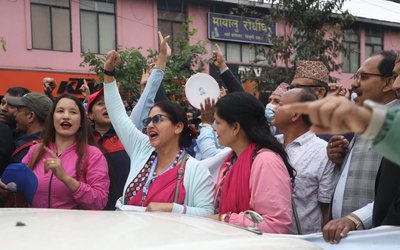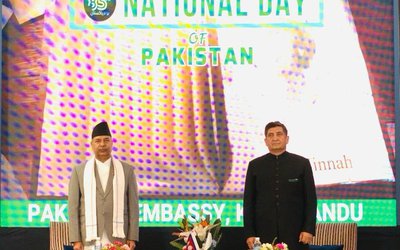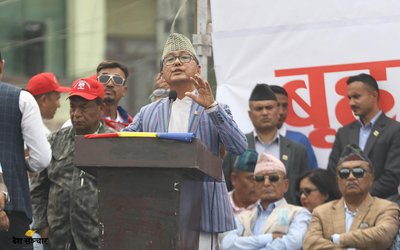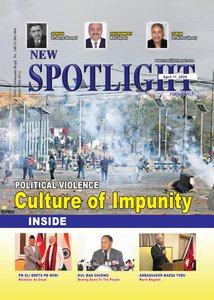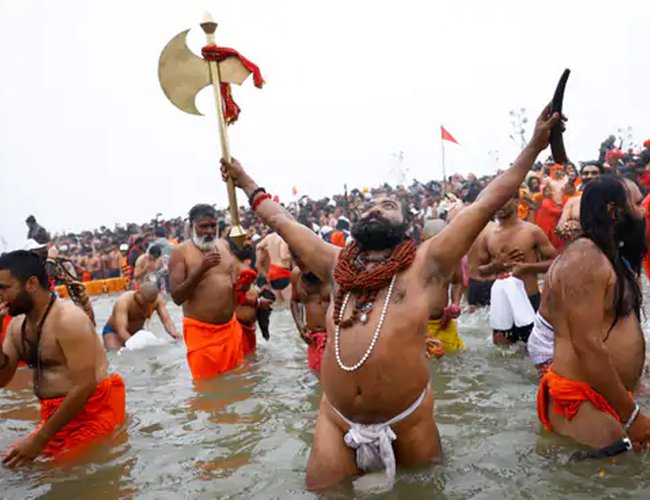
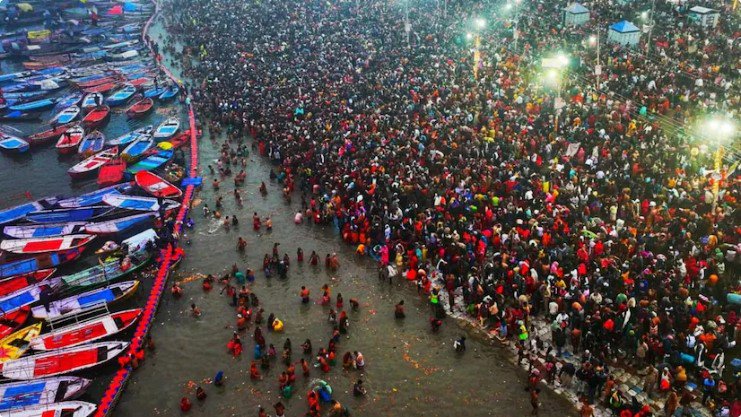
Nepalese Hindus are flocking to Prayag Raj in an organized manner, affiliating with various religious organizations and individuals. Some are visiting individually or in small groups. Nepalese pilgrims are being provided with temporary shelter by religious groups like Pilot Baba, Ishkon, and others.
Sanhitashastri Arjun Prasad Bastola, patron of the Brahmin International Organization Trust, has arranged free accommodation and meals for Nepali pilgrims at the ongoing Maha Kumbha in Prayagraj, India.
With over 10 million devotees visiting daily, Bastola ensures that Nepali pilgrims have no trouble finding food and lodging. The Maha Kumbha, held once every 144 years, serves around 200 Nepali devotees daily. Other visitors to Prayagraj are utilizing private lodges, hotels, and other facilities for overnight stays during the Kumbha.
Maha Kumbh Mela 2025:
The Mahakumbh 2025 in Prayagraj is set to be a momentous spiritual gathering, attracting over 450 million devotees from across the globe. This sacred event, deeply rooted in Sanatan Dharma, showcases ancient traditions and cultural splendor. With state-of-the-art technology, enhanced safety protocols, and meticulous planning, it ensures a safe and transformative experience for the pilgrims.
The Maha Kumbh Mela is a major Hindu festival that takes place every 12 years in Prayagraj, India. It commenced on January 13, 2025, and will run until February 26, 2025. It is anticipated to draw approximately 400 million (40 crores) visitors, making it the largest religious gathering in the world.
The festival's origins lie in Hindu mythology, symbolizing the triumph of gods over demons. Followers believe that bathing at the confluence of the Ganges, Yamuna, and mythical Saraswati rivers purifies sins and leads to salvation.
To accommodate the massive number of pilgrims, authorities have established a temporary city spanning 4,000 hectares.
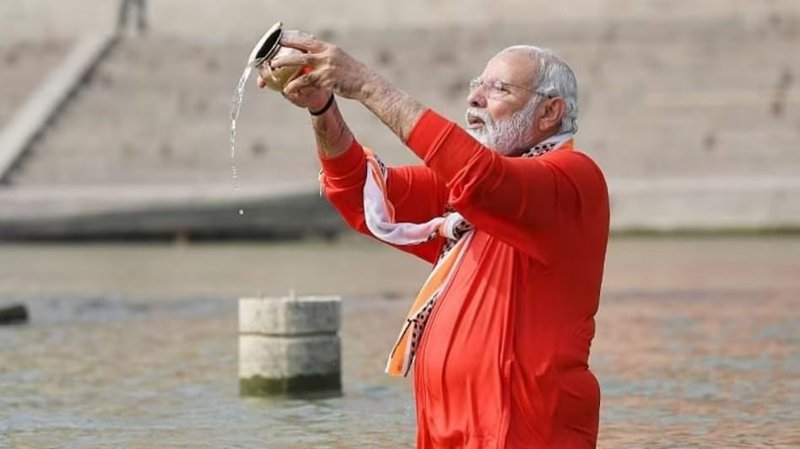
The Maha Kumbh Mela is not only a significant religious event but also a testament to India's capability to manage large-scale gatherings, showcasing the country's rich cultural heritage.
Significance of the Maha Kumbh Mela in Hindu Tradition
The Mahakumbh Mela of this year commenced on the auspicious day of Paush Purnima, which occurred on January 13, 2025, and will run until February 26, 2025. This year's Mahakumbh Mela is particularly special as the alignment of constellations occurs once every 144 years.
The Maha Kumbh Mela is a significant religious gathering in Hinduism, held every twelve years at four sacred sites: Prayagraj (formerly Allahabad), Haridwar, Ujjain, and Nashik.
This festival carries deep spiritual importance, rooted in Hindu mythology and tradition.
Mythological Background
The origins of the Kumbh Mela are associated with the Samudra Manthan, or the churning of the ocean, where gods (Devas) and demons (Asuras) collaborated to obtain Amrit, the nectar of immortality.
Legend has it that during this process, a pot (Kumbh) containing Amrit surfaced. To prevent the demons from seizing it, Lord Vishnu, disguised as Mohini, took the pot and escaped. In the process, drops of Amrit fell at four locations: Prayagraj, Haridwar, Ujjain, and Nashik.
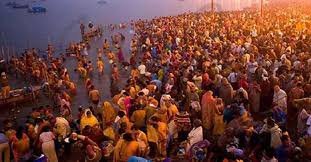
These places have since become revered pilgrimage spots for Hindus, believed to confer spiritual blessings on those who bathe in their waters during the festival.
Spiritual Significance
The main ceremony of the Maha Kumbh Mela is the Shahi Snan, or royal bath, where millions of pilgrims bathe in the holy rivers at specific times.
This ritual is believed to purify individuals of their sins and free them from the cycle of rebirth (samsara), leading to Moksha or spiritual liberation.
The meeting point of the Ganga, Yamuna, and the mythical Saraswati at Prayagraj is highly revered for achieving salvation.
Cultural and Social Aspects
Apart from its religious significance, the Maha Kumbh Mela is a lively cultural festival that brings together various groups of people, including ascetics (sadhus), pilgrims, and visitors who participate in rituals like fasting, charity, and communal prayers. This gathering promotes a sense of unity among participants, transcending differences in caste and creed.
The event also highlights India's cultural heritage through its traditions and customs passed down through generations.
Through the use of four dredging machines, an additional 26 hectares of land have been reclaimed, tripling the Sangam's capacity compared to 2019.
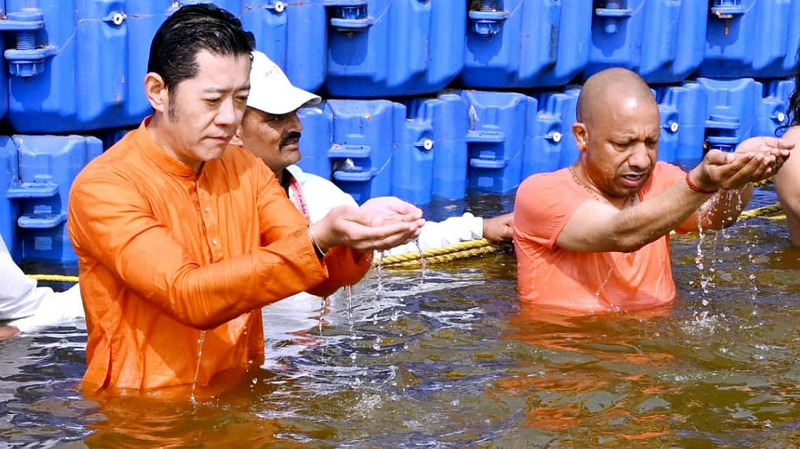
These improvements ensure a seamless bathing experience for the estimated 45 crore devotees expected to attend the Maha Kumbh.
Infrastructure and Logistics
Mela Area: The event will encompass roughly 4,000 hectares, marking a 25% growth from the previous Kumbh Mela held in 2019.
Sectors: The area has been segmented into 25 sectors, an increase from the 20 sectors in 2019, improving crowd management.
Ghat Lengths: The combined length of bathing ghats has expanded from 8 kilometers in 2019 to 12 kilometers in 2025.
Parking Facilities: Parking capacity has been enlarged to 1,850 hectares, up from the previous 1,291 hectares.
Road Infrastructure: The total road network within the Mela area has grown from 299 kilometers to over 450 kilometers.
Budget and Economic Impact
Estimated Budget: The budget allocated for organizing the Maha Kumbh Mela is approximately ₹7,500 crore (around $903.61 million), a substantial increase from previous events.
Economic Transactions: The Maha Kumbh Mela is projected to generate an estimated amount of ₹2 lakh crore to ₹2.5 lakh crore (approximately $25 billion to $30 billion), potentially representing about 0.8% of India's GDP, as per the Confederation of All India Traders (CAIT).
Tourist Spending: If each tourist spends ₹5,000 during their visit, the Maha Kumbh Mela is expected to generate an estimated amount of ₹2 lakh crores. Additionally, according to CIAT, around ₹40,000 crore is projected to be generated by local guesthouses, hotels, motels, restaurants, and more.
The helicopter service charges ₹5,000 per trip and accommodates 7,000 pilgrims daily. Over a 45-day period, this service alone could potentially generate up to ₹157.5 crore in total (₹3.5 crore per day).
Sanitation and Safety Measures
Toilets and Facilities: Approximately 1.50 lakh toilets will be installed, an increase from 1.14 lakh in 2019. The number of public accommodation beds has also increased from 20,000 to 25,000.
Security Personnel: More than 45,000 police personnel, supported by over 55 police stations, will be deployed for safety and security during the event.
Surveillance Technology: Over 3,000 cameras will be utilized to monitor the area as part of enhanced security measures.
Mahakumbha Mela
The Maha Kumbh Mela, one of the largest spiritual gatherings in the world, commenced on January 13 in Prayagraj, Uttar Pradesh. Considered a significant event in Hindu tradition, this massive gathering attracts millions of devotees, ascetics, and seekers from around the world.
The Maha Kumbh of this year is of great significance due to its alignment with unique celestial configurations that occur once every 144 years, enhancing its spiritual importance. January 13 holds special significance as the sun enters Capricorn or Makar on this day, marking the beginning of Uttarayan, which is considered an auspicious time for important activities (shubh karya). According to Acharya Lalmani Panday, those who pass away during this period are believed to ascend to Vaikuntha, the celestial abode of Lord Vishnu, as Bhishma Pitamah did.
The main festival is celebrated at four sacred sites in India, each situated along the banks of a holy river, in a 12-year cycle. These sites are Haridwar on the Ganges River in Uttarakhand, Ujjain on the Shipra in Madhya Pradesh, Nashik on the Godavari in Maharashtra, and Prayagraj in Uttar Pradesh where the Ganges, Yamuna, and mythical Saraswati rivers meet. The celebrations at each site are based on specific astronomical positions of the Sun, Moon, and Jupiter, with the most sacred time being when these positions align perfectly.
Types of Kumbh Melas
The Kumbh Melas, which last for several weeks, are celebrated at different times and locations in accordance with Hindu tradition. These gatherings are of great spiritual importance and draw millions of devotees from around the world. The frequency of the melas varies, with some happening annually and the Maha Kumbh Mela occurring every 144 years in Prayagraj.
What is Kumbh Mela?
Kumbh Mela is a religious gathering that attracts tens of millions of Hindu pilgrims and spiritual seekers from India and beyond.
The event is steeped in Hindu mythology and revolves around the belief in the purifying power of sacred rivers. Pilgrims participate in ritual bathing in these rivers, believing it cleanses their sins and brings them closer to spiritual liberation.
The festival rotates between four main locations in India: Prayagraj (formerly Allahabad), Haridwar, Nashik, and Ujjain. Each location is associated with a sacred river - the Ganges, Godavari, or Shipra.
A complete Kumbh Mela is held every 12 years in the four cities. A half ("Ard") Kumbh is held midway between two full Kumbhs.
Authorities have confirmed that the 2025 festival will be a Maha (Great) Kumbh Mela, which occurs only once every 144 years, making it an even more significant occasion.
Why do people go to Kumbh Mela?
Kumbh Mela attracts a diverse range of attendees, including sadhus, ordinary citizens, families, and international visitors.
While the majority of participants are Hindus, people from other faiths also show interest in the event for its cultural and spiritual significance. The festival provides an opportunity for attendees to seek spiritual renewal and salvation through rituals such as bathing in the holy rivers, which is believed to cleanse sins and bring them closer to spiritual liberation.
For many, the pilgrimage to Kumbh Mela is a unique experience to strengthen their faith, connect with others, and immerse themselves in Hindu traditions. By embracing
the spiritual and wellness aspects of the event, Nepalese participants not only celebrate their shared heritage but also embark on a personal journey of transformation. The Kumbh Mela serves as a powerful reminder of the transformative power of spirituality in promoting holistic health, peace, and harmony across borders, especially considering its rare occurrence once every 144 years.

Keshab Poudel
Poudel is the editor of New Spotlight Magazine.
- KUL MAN GHISING: Bowing Down To The People
- Apr 13, 2025
- POLITICAL VIOLENCE: Culture of Impunity
- Apr 11, 2025
- PM OLI MEETS PM MODI: No Progress
- Apr 09, 2025
- PM OLI’S THAILAND VISIT: Flip Flop
- Apr 08, 2025
- FM Dr. Deuba’s India Visit: Mission Aborted
- Mar 26, 2025


